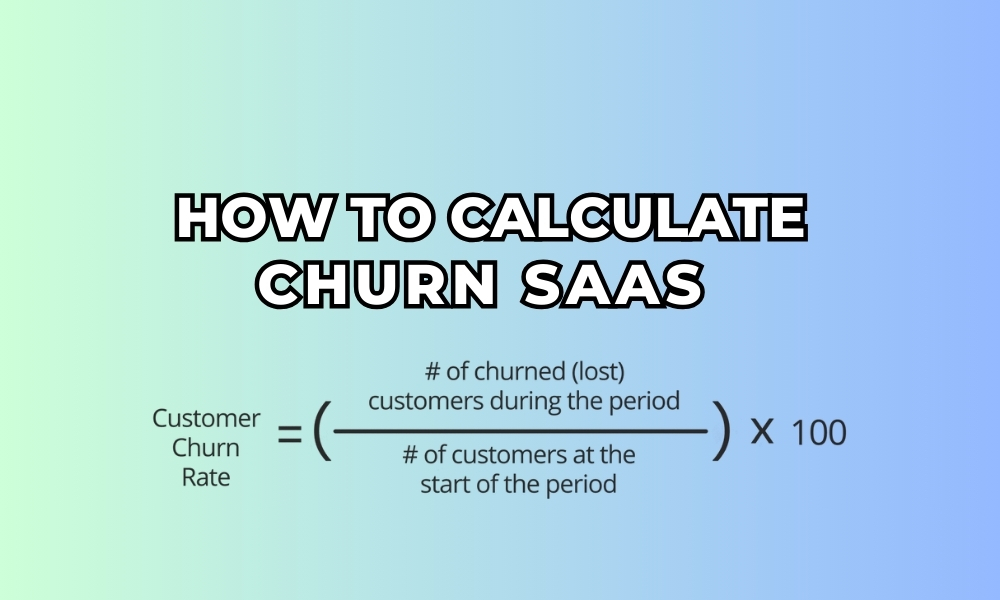The churn rate is measured by dividing the number of customers lost in a period by the total number of active customers at the beginning of that period.
Though the term is very short, it is more likely a red flag for a company, highlighting the dissatisfaction level of your customers. Through this, businesses can find out the key areas for improvement and strategies to keep the customers they already have.

What Is The Churn Rate In The Saas Business?
The churn rate in a Saas business refers to the percentage of such a group of people who have canceled their subscriptions over a specific period of time. The average churn rate of a SaaS company should be 3-8% on a monthly basis, whereas about 32-50% on an annual measurement.
This is one of the most important metrics in the SaaS business that directly impacts the revenue stream you generate from the customer journey. A high churn rate defines the revenue loss, and that’s what you must work on to reduce the percentage and increase customer lifetime value.
Why Calculating Churn Rate Important In Saas Business?
Calculating the churn rate is important for any SaaS company as through it, you can measure customer retention as well as the financial health of your business. A high churn rate means there are red signs alerting areas that need focus. The revenue you are assuming is losing faster than you are gaining it.
The best possibility is that the product and website you present are not meeting the needs of the target audience or there’s a lack of internal features. Together with the churn rate, you can easily identify the reasons associated with it and prevent further churn. According to the research available, only a 5% reduction in the churn rate can increase profits by 25% to 95%.

How To Calculate Churn Saas?
To calculate the churn rate in any of your subscription-based businesses, you need to divide the number of customers who canceled their subscription with the service by the number of customers at the beginning of the business. Then simply multiply your result by 100 to get the churn number in the percentage form.
With the use of this go-to method, you can easily define the churn rate of your business over a specific period, whether you want it on a monthly, quarterly, or annual basis, it all depends on its needs.
Customer Churn Rate Formula
There is a specific calculation formula to find out the churn rate of any business with the software-as-a-service model. Here you go with the formula:
Churn Rate: (the number of lost customers during a period / total number of customers you have at the beginning of your business) * 100%
The SaaS business usually runs on the cloud computing infrastructure and subscription-based revenue model. People check in and select the desired plan or service, complete the subscription, and initiate their journey with the company.
Over time, there would be contingents of customers who have canceled their subscriptions or just stopped using your SaaS products in a specific period of time.
Various reasons would be responsible for it, such as poor customer support, lack of essential features in the service that customers need, high pricing, complicated user experience, and so on.
However, the customers that have already left your service refer to the churn customers. Now you need the number of active customers who are with you at the very start of the chosen period. Now that you have two essential values right in your hand, you can easily complete your SaaS business churn rate calculation.
SaaS Churn Rate Calculation Example
For example, you have the owner of a SaaS company, “CloudNotes,” where you provide a cloud-based note-taking and organization tool.
Now, at the beginning of January last year, you had 500 customers who paid for your service. But after transitioning into the new month, suddenly, you have noticed that about 25 customers canceled their subscriptions.
Here, the number of lost customers you have found: 25
And the total customers at the beginning of the period: 500
Now simply apply the formula:
Churn Rate: (25 / 500) * 100%
= 0.05 * 100%
Or, 5%
It clearly means only 5% of total customers in your CloudNotes have canceled their subscriptions. Also, you can define the rate as the key indicator of your customer satisfaction level. Though only 5% of churn is not something that you need to worry about, it is best to find out the reason to prevent churn.

How To Calculate Revenue Churn Rate?
If you want to know the churn rate in terms of revenue stream for your SaaS business, simply you will need the total revenue loss from customers who had canceled their subscriptions in a specific period of time.
Now divide the number by the monthly recurring revenue you had at the beginning of that period. After calculation, you have to multiply the result by 100 and get the revenue churn rate in percentage.
In the case of calculating the churn rate where you get data on lost customers, you are getting the percentage of the revenue lost through this method.
To make things easier, follow this simple formula:
(churned revenue in a period / monthly recurring revenue over a specific period of time) * 100%
Example:
A SaaS company, “DataFlow,” is calculating its revenue churn rate over the month of March. While doing this, they found that up to 5 customers have canceled their subscription on their $1,000/month plan, where the revenue lost is about $5,000. Besides, they also see that 10 more customers have canceled their plan of $500/month, where their revenue lost is about $5,000.
That means, total churned revenue = $10,000
And beginning MRR of that month was about = $100,000
So, revenue churn rate: ($10,000 / $100,000) * 100%
Or, 10%. It defines that the company lost about 10% of its recurring revenue during that month.
Final Words
It is important to track down your customer journey in your SaaS business, and the churn rate comes in the top place. Not just calculating the churn rate will be enough, you need to take proactive steps according to the analysis. Find underlying problems with your product or service and fix them as soon as possible. Focus on making your service easy to integrate, listen to your customer feedback, and ensure great support to reduce the churn rate in SaaS.
Author
Shirikant is a proven customer success leader who combines sharp business insight with practical experience to improve retention and drive revenue. As the founder of Statwide, he designs customer-first business strategies that guide companies to turn users into loyal and long-term partners. His approaches are built on real results: stronger relationships, higher customer value, and lasting growth.








